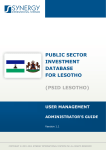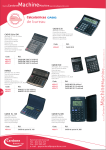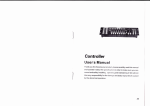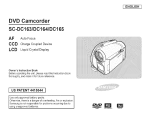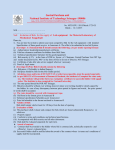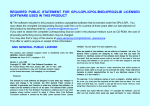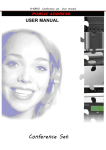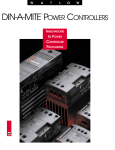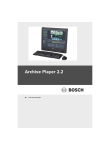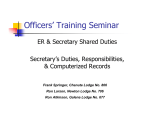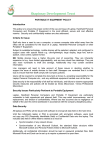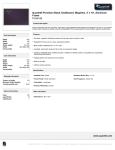Download JC Nov F2F and 11 13 2014 Meeting FINAL
Transcript
This document is part of the NSF International standard development process. This document is subject to change and may be a draft and/or non-final version. Committee members may request permission to reproduce, quote from, and/or circulate this document to persons or entities outside of their organization after first receiving written permission from NSF International. Send written requests to NSF International that include notice of to whom and for what purpose this document is to be shared. TG Submission NSF 426 TG 9 & 10 – Design for Repair, Reuse and Recycling & Product Longevity TG 9 & 10 status summary: The TG has completed a recommended draft set of criteria with 6 prerequisites and 5 optional criteria for Section 9, 2 prerequisites for Section 10, and one optional criterion for consideration in another section. Points Criterion Number and Title Status* Reference (option document al only) Section 9 - Design for Repair, Reuse and Recycling Prerequisite Criteria 9.1.1 Design for Repair, Reuse and JC Straw Balloted June 2014 Recycling 9.1.2 Design for Plastics Recycling JC Straw Balloted October 2014 9.1.3 Product Recyclability Calculation TG Recommendation for revision and Minimum 90% Recyclability Rate as requested by JC (with modification) 9.1.4 Information and Reporting in TG Recommendation Preparation for Re-use and Recycling 9.1.5 Functionality Testing Software Tools TG Recommendation for revision as requested by JC 9.1.6 Informing Reuse Operators and TG Recommendation Treatment Operators of Information Available for their Assistance (Corporate) Optional Criteria 9.2.1 Reduction of Materials Incompatible TG Recommendation with Recycling 9.3.1 Product Marked to Identify JC Straw Balloted June and Components with Special Handling Needs October 2014 – TG recommendation for clarification 9.4.1 Minimum 95% Recyclability Rate TG Recommendation for revision as requested by JC (with modification) 9.4.2 Recyclability Calculation TG Recommendation (2 Options) Incorporating Economic Feasibility 9.5.1 Information and Reporting on Disk TG Recommendation Drive Magnet Type and Location Section 10 – Product Longevity Prerequisite Criteria 10.1.1 Replacement Components TG Recommendation Availability 10.1.2 Product User and Reuse Operator TG Recommendation Access to Enabling Code Optional Criteria - None Other Criteria (to be consider for another section) x.x.x Postconsumer Recycled Content of TG Recommendation Rare Earth Elements © 2014 NSF International None None Memo to JC from TG 9/10 None None None None Memo to JC from TG 9/10 Memo to JC from TG 9/10 None None None This document is part of the NSF International standard development process. This document is subject to change and may be a draft and/or non-final version. Committee members may request permission to reproduce, quote from, and/or circulate this document to persons or entities outside of their organization after first receiving written permission from NSF International. Send written requests to NSF International that include notice of to whom and for what purpose this document is to be shared. 9 Design for Repair, Reuse and Recycling 9.1 Prerequisites 9.1.1 Design for Repair, Reuse and Recycling (JC Straw Balloted June 2014) The product shall be designed with the following features to facilitate repair, preparation for reuse, recycling, and safe handling. − External enclosures shall be removable by hand without destruction of the enclosure or with commonly available tools. − Components with special handling needs listed in Annex VII of the European WEEE Directive 2012/19/EU shall be identified, accessible, and removable by hand or with commonly available tools. − At a minimum, if present in the product – data drives or cards, processor, memory DIMMs, power supply, fans and I/O cards – shall be accessible and replaceable by hand or with commonly available tools. − Wires and cables that connect to external sources of power or data shall be removable from all products by hand or with commonly available tools without either the cable or the component being rendered unusable, unless required for technical or safety reasons. In order for a component to be considered “accessible” for the purposes of this criterion it shall, following removal of the enclosure, be visible without removal of other components and shall be removable without having to remove more than one or two other components. The removal referred to in this paragraph shall be non-destructive. In order for a component to be considered “identified” for the purposes of this criterion either the component shall be called out in the product disassembly report called for in prerequisite 9.1.4 or marked with a visual display as called for in 9.3.1. 9.1.2 Design for Plastics Recycling (JC Straw Balloted October 2014) All plastic parts >100 g shall meet the following: − Clearly marked with material type in accordance with ISO 11469/1043, with the exception of printed circuit boards, wire and cables. − Separable by hand or with commonly available tools, such that plastic parts could be separated into parts with the same material type. “Not Applicable” may be declared by manufacturer if the product does not contain plastic parts weighing >100 g. © 2014 NSF International This document is part of the NSF International standard development process. This document is subject to change and may be a draft and/or non-final version. Committee members may request permission to reproduce, quote from, and/or circulate this document to persons or entities outside of their organization after first receiving written permission from NSF International. Send written requests to NSF International that include notice of to whom and for what purpose this document is to be shared. Note: For components containing plastic parts, the 100 g threshold applies to the plastic part only. 9.1.3 Product Recyclability Calculation and Minimum 90% Recyclability Rate TG Recommendation for revision as requested by JC (with modification) The product shall have a recyclability rate of at least 90% using technology and processes available at the time of product declaration or verification. The calculation of recyclability rate shall utilize the methodology in IEC/TR 62635 (see Annex E of IEC/TR 62635 for a calculation template). Comment [P1]: 11/6/14 JC approved as submitted by consensus to move to straw ballot. Manufacturer shall perform a calculation for the recyclability of the product using the IEC TR62635 methodology, and shall make the assumptions, methodology and calculation results publicly available and readily accessible on their web site. A link to that information shall be declared. The product shall have a minimum recyclability rate of 90% by weight and based on technology and processes available at the time the product is declared to conform to this Standard. Determination of the recyclability rate shall start with the receipt of the untreated waste equipment (if beyond re-use) and end when the end-of-waste status for fractions is achieved. Circuit board substrate material, included in circuit boards that will be sent to a smelter for metals recycling, shall be considered recyclable for the purpose of the calculation. The methodology shall identify the recycling technologies and practices that are sufficient for achieving the claimed recyclability rate. These technologies and practices must be common in existing recycling systems, though they need not be available everywhere or throughout the world. Also, the methodology shall identify the information about the product from the manufacturer which would be needed by a treatment operator in order to achieve the claimed rates. 9.1.4 Information and Product Disassembly Reporting in Preparation for Re-use and Recycling (PrerequesitePrerequisite for Silver and Gold) TG Recommendation Manufacturer shall provide the following information on a publicly accessible website to facilitate product disassembly and safe handling of the product: − A disassembly or end of life characterization report that demonstrates conformity to all the prerequisites in Section 9.1. − List of components with special handling needs identified in the European WEEE Directive 2012/19/EU, the location of these components in the product, and guidance for the identification and safe removal of these components. The information shall be made public within one year of first market release of the product in any region or country. Manufacturer shall declare on the Product Registry the date of market release at the time of product registration. The URL where the above required information is located shall be declared no later than one year after the declared date of market release. The manufacturer shall publish a “manual” for third party re-use and recycling organizations, in at least English, with the information listed below, including the same information as provided by the manufacturer for use by its technicians for the same purposes as follows: − Manual shall be available on a publically accessible website without restriction or registration requirements for access. The manufacturer shall declare the URL of the public disclosure. © 2014 NSF International Comment [P2]: 11/13/14 JC approved by consensus to move to straw ballot. This document is part of the NSF International standard development process. This document is subject to change and may be a draft and/or non-final version. Committee members may request permission to reproduce, quote from, and/or circulate this document to persons or entities outside of their organization after first receiving written permission from NSF International. Send written requests to NSF International that include notice of to whom and for what purpose this document is to be shared. − The manual shall be published within one year after the product is placed on the market in any region or country and the manufacturer shall have a written procedure that makes the manual publically available for a minimum of 7 years following the end of production of the product. − Manufacturer shall declare on the Registry the date of market release of the product and provide a link to where the manual is published. The manual shall contain the following information about preparation for re-use and recycling: − The different EEE components and materials; and − The location of materials with special handling needs as identified in WEEE Directive 2012/19/EU Annex VII ; and − Technical reference of each individual sub-assembly providing pin diagram and make and model of each connector capable of being field terminated as provided to manufacturer repair/authorized service centers; and − The Identify what components that cannot be replaced by non-manufacturer supplied components; and − Provide aAn updated list, at least annually, of any components provided by the manufacturer that are compatible or equivalent with original components; and − A disassembly or end of life characterization report that demonstrates conformity to all the prerequisites in Section 9.1 and includes, at a minimum, step-by-step disassembly instructions with required tools, product specifications and troubleshooting information. − The function specified in the manufacturer’s user manual, repair manual or technical manual should be used to determine original intended function, and to assist with the preparation for re-use or treatment operations. The manual shall meet the following formatting requirements: − Available in Useruser-friendly formatting on the web and as downloadable PDFs for offline viewing; and − Available in Machinemachine-friendly file format: either XML or oManual/IEEE 1874 – IEEE Standard for Documentation Schema for Repair and Assembly of Electronic Devices; and − Provided under an open-source license that allows redistribution and modification such as Creative Commons (www.creativecommons.org) (CC-BY). 9.1.5 Functionality Testing Software Tools (JC Straw Balloted October 2014) TG Recommendation for revision as requested by JC and modification The manufacturer shall make publically available and readily accessible, and provide access to the necessary hardware functionality testing software tools and applicable updates to ensure the product meets operating specifications and can be returned to service as provided by the manufacturer’s repair/authorized service centers. Manufacturer shall also make available and provide access to any system or peripheral firmware (BIOS, etc.) and drivers for the server hardware. The manufacturer shall have a written procedure that makes all of these items available for a minimum of 7 57 years following the end of production of the product and identifies if there is a cost. The © 2014 NSF International Comment [P3]: 11/6/14 JC approved as modified by consensus to move to straw ballot. This document is part of the NSF International standard development process. This document is subject to change and may be a draft and/or non-final version. Committee members may request permission to reproduce, quote from, and/or circulate this document to persons or entities outside of their organization after first receiving written permission from NSF International. Send written requests to NSF International that include notice of to whom and for what purpose this document is to be shared. manufacturer shall declare if there will be any cost associated with the provision of the functionality testing software tool. The manufacturer shall declare the URL of the public disclosure. 9.1.6 Informing Reuse Operators and Treatment Operators of Information Available for their Assistance (Corporate) TG Recommendation Comment [P4]: 11/13/14 JC approved as modified by consensus to move to straw ballot. Manufacturers shall inform reuse operators and treatment operators with which they, or an organization working on their behalf, have a business relationship for providing end-of-service/end-oflife management of the products declared to this standard regarding the availability of the following information provided under any of the following criteria to which they declare conformance: 9.1.4, 9.3.1, and 9.5.1. • The publishing on a publically available web site of a manual on preparation of the product for reuse and recycling (Required criterion 9.1.4). The URL of the web site shall be provided to the reuse operators and treatment operators. • If the manufacturer declares conformance with optional criteria 9.3.1 and/or 9.5.1, the placement of the QR codes on the registered products, or components of those products, that can be read by a cell phone with the appropriate app. The QR code links to the following sources of information: o A web site that identifies components and materials with special handling needs, which are those listed in WEEE Directive 2012/19/EU Annex VII (criterion 9.3.1) o A web site that provides information on magnet type and location in hard disk drives to facilitate recovery of rare earth elements contained in those magnets (criterion 9.5.1) The method of informing reuse operators and treatment operators shall be in writing and shall be demonstrated by provision of the distributed written document and a record of its distribution. 9.2 Design for Plastics Recycling (Optional) 9.2.12 Reduction of Materials Incompatible with Recycling Plastics Separable from Metals TG Recommendation Plastic parts >100 g, shall not contain molded, glued or otherwise attached metal inserts or metal fasteners, unless the metal component can be snapped off manually or removed with commonly available tools. with the exception of printed circuit boards, wire and cables, shall not have: − Molded, glued or otherwise attached metal inserts or metal fasteners, unless the metal component can be completely snapped off manually or entirely removed with commonly available tools. − Applications or additives including aAdhesives, coatings, paints, or finishes, or pigments that have a significant impact on the physical or mechanical properties of the plastic when it is recycled. This shall be demonstrated by either: o Test results showing no more than a 25% reduction in either the notched Izod impact at room temperature between a test sample made from the original plastic without the applications or additives adhesives, coatings, paints, or finishes and test sample made from the plastic with the applications or additivesadhesives, coatings, paints, or finishes © 2014 NSF International Comment [P5]: 11/13/14 JC approved as modified by consensus to move to straw ballot This document is part of the NSF International standard development process. This document is subject to change and may be a draft and/or non-final version. Committee members may request permission to reproduce, quote from, and/or circulate this document to persons or entities outside of their organization after first receiving written permission from NSF International. Send written requests to NSF International that include notice of to whom and for what purpose this document is to be shared. , as measured using ASTM D256 or ISO 180, or the Charpy impact for the same test samples as measured using ISO 179; or o Peer reviewed published literature concluding no significant impact. “Not Applicable” may be declared by manufacturer if the product does not contain plastic parts weighing >100 g. 9.3 Identification of Components with Special Handling Needs (Optional) 9.3.1 Product Marked to Identify Components and Materials with Special Handling Needs (JC Straw Balloted June 2014 and October 2014) TG Recommendation for clarification The product shall visually display information on the presence and location of all components and materials with special handling needs as identified in the European WEEE Directive 2012/19/EU Annex VII. The information shall be provided on a label or other permanent marking located on the product itself or visible upon removal of the external housing in order to clearly identify the presence before any treatment. The label, or permanent marking, shall contain a QR code, linked to the required information, and is not required to be co-located with other labels. Comment [P6]: 11/6/14 JC approved as submitted by consensus to move to straw ballot Products that contain no components with special handling needs as identified in the European WEEE Directive 2012/19/EU Annex VII may claim this point. A label or other permanent marking located on the product itself shall indicate the absence of components with special handling needs. 9.4 Product Recyclability Rate (Optional) 9.4.1 Minimum 95% Recyclability Rate TG Recommendation for revision as requested by JC (with modification) Comment [P7]: 11/6/14 JC voted to table criterion. Inconclusive (in favor 7; against 5; 3 abstain.) The product shall have a minimum recyclability rate of 95% by weight using the calculation from 9.1.3 and based on technology and processes available at the time the product is declared to conform with this criterion. The calculation shall be conducted for each country or region into which the product is registered, considering the available recycling systems and technologies available in that country or regions or in the countries or regions where the products are to be actually recycled (to the best knowledge of the manufacturer itself). Thus the product may have different recyclability calculations for different county or regions, each of which shall exceed the 95% rate. The product may be declared differently in different countries or regions. 9.4.2 Recyclability Calculation Incorporating Economic Feasibility TG Recommendation for revision as requested by JC The recyclability calculation in 9.1.3 shall also address the following factors for all the materials assessed as recyclable: − The time and cost required to liberate and process materials from the registered product into secondary commodities for which there is a market. Data used for determining cost, and the source of the data, shall be identified. © 2014 NSF International Comment [P8]: 11/6/14 JC sent back to TG to rework to require design consultation This document is part of the NSF International standard development process. This document is subject to change and may be a draft and/or non-final version. Committee members may request permission to reproduce, quote from, and/or circulate this document to persons or entities outside of their organization after first receiving written permission from NSF International. Send written requests to NSF International that include notice of to whom and for what purpose this document is to be shared. − Option #1: The net economics of processing by determining the market revenues of the liberated secondary materials and subtracting the cost to liberate as determined in 1 above. Data used for material revenues, and the source of the data, shall be identified. Option #2: No 2nd bullet. Rationale: market values are considered commercially sensitive and should therefore not be included. Manufacturer shall convene a design-stage consultation with a recycler for the registered product, resulting in a report. 9.5 Rare Earth Recovery and Recycling (Optional) 9.5.1 Information and Reporting on Disk Drive Magnet Type and Location TG Recommendation Comment [P9]: 11/6/14 JC approved as submitted by consensus to move to straw ballot. The manufacturer shall indicate the type of actuator/voice coil and spindle magnets in the product’s hard disk drive on the external casing of the hard disk drive by means of a QR code. The QR code shall link directly to the magnet type and location information on a publically available database or the manufacturer’s web site in at least English. The QR code shall be printed in black on a white background if one or more of the magnets contain Neodymium. The magnet type shall be identified as Neodymium iron boron. The QR code shall include a non-machine readable chemical symbol (Nd) (see Annex X). In the case that neither magnet contains Neodymium, the QR code shall be printed in red on a white background. The voice coil and the spindle magnet locations in the hard disk drive shall be identified by metric measurements from the edges of the disk drive. 10 Product Longevity 10.1 Prerequisites 10.1.1 Service Agreement or Warranty The manufacturer shall offer a minimum three year service agreement or warranty for the product. 10.1.12 Replacement Components Parts Availability TG Recommendation Product replacement components parts and/or product service shall be made available through the manufacturer or an authorized third party for at least five 7 -5 years after the product is first placed on the market end of production. Replacement components parts shall include, at a minimum, power supplies, fans, hard drives, memory, processors and printed circuit boards motherboards (need discussion of this list). Information regarding the availability of product replacement components parts and/or product service shall be publicly available on the manufacturer’s website. The manufacturer shall declare the URL of the public disclosure. © 2014 NSF International Comment [P10]: 11/6/14 JC approved as modified by consensus to move to straw ballot This document is part of the NSF International standard development process. This document is subject to change and may be a draft and/or non-final version. Committee members may request permission to reproduce, quote from, and/or circulate this document to persons or entities outside of their organization after first receiving written permission from NSF International. Send written requests to NSF International that include notice of to whom and for what purpose this document is to be shared. 10.1.2 Product User and Reuse Operator Access to Enabling Code TG Recommendation All enabling code provided with the product at time of purchase for purposes of machine function, including all firmware, microcode, diagnostics, access controls or synonyms, including all safety, security, and error correction patches and fixes shall be entitled to the device. No EULA (End User License Agreement) can be added removing this criterion. Comment [P11]: Action Item: Wayne to ask Gay to see if criterion 9.1.5 addresses this topic; if not, ask Gay to write up rationale Comment [P12]: Commercial term 10.2 Upgradeability (Optional) 10.2.1 Upgradeability/Capability Enhancement The product shall be designed for upgradeability or capability enhancement for, at a minimum, hard drives, PCIe adapters, memory, and processors (need discussion on this list). These options shall be able to be installed by hand or with commonly available tools. Other Criteria (to be consider for another section) x.x.x Postconsumer Recycled Content of Rare Earth Elements TG Recommendation (optional) Product must shall contain a hard drive with an actuator/voice coil and/or spindle magnets which contain 5% or more postconsumer recycled content neodymium or dysprosium .by weight of the magnet. The neodymium or dysprosium shall be provided through the recycling of magnets from used devices. Manufacturer shall provide documentation from the disk drive supplier confirming that the product contains a hard drive with 5% or more postconsumer recycled content neodymium or dysprosium. © 2014 NSF International Comment [P13]: 11/6/14 JC approved to add criterion to Section 7 as modified by consensus to move to straw ballot.








